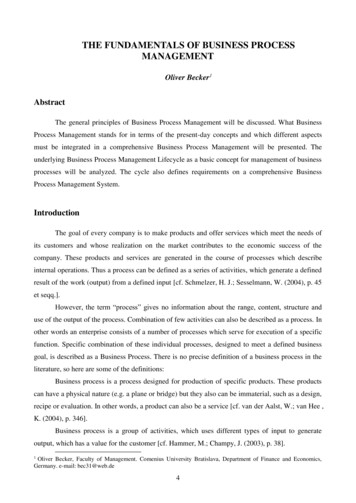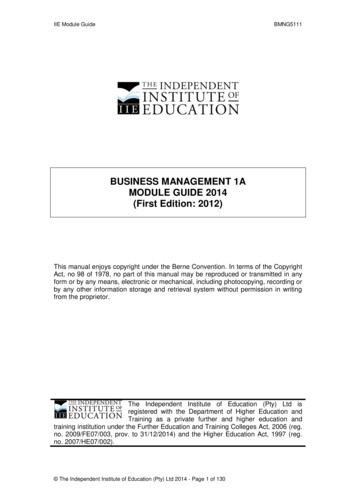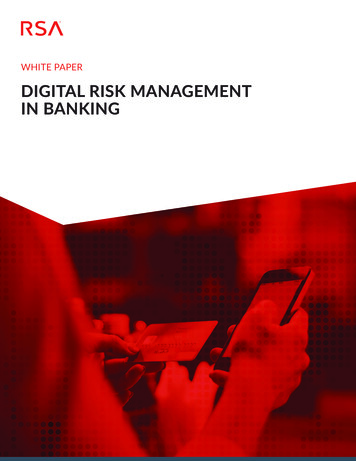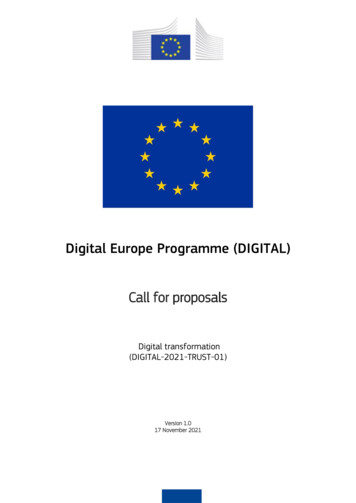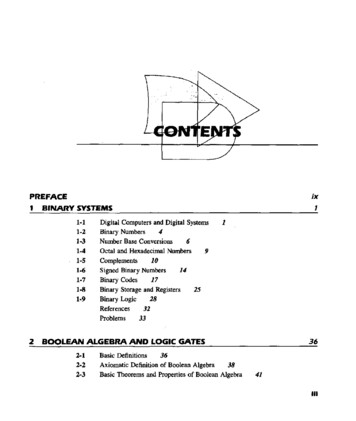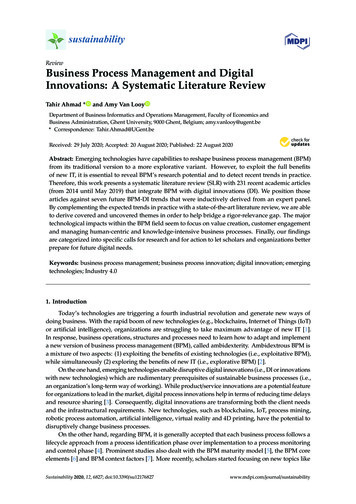
Transcription
sustainabilityReviewBusiness Process Management and DigitalInnovations: A Systematic Literature ReviewTahir Ahmad *and Amy Van LooyDepartment of Business Informatics and Operations Management, Faculty of Economics andBusiness Administration, Ghent University, 9000 Ghent, Belgium; amy.vanlooy@ugent.be* Correspondence: Tahir.Ahmad@UGent.beReceived: 29 July 2020; Accepted: 20 August 2020; Published: 22 August 2020 Abstract: Emerging technologies have capabilities to reshape business process management (BPM)from its traditional version to a more explorative variant. However, to exploit the full benefitsof new IT, it is essential to reveal BPM’s research potential and to detect recent trends in practice.Therefore, this work presents a systematic literature review (SLR) with 231 recent academic articles(from 2014 until May 2019) that integrate BPM with digital innovations (DI). We position thosearticles against seven future BPM-DI trends that were inductively derived from an expert panel.By complementing the expected trends in practice with a state-of-the-art literature review, we are ableto derive covered and uncovered themes in order to help bridge a rigor-relevance gap. The majortechnological impacts within the BPM field seem to focus on value creation, customer engagementand managing human-centric and knowledge-intensive business processes. Finally, our findingsare categorized into specific calls for research and for action to let scholars and organizations betterprepare for future digital needs.Keywords: business process management; business process innovation; digital innovation; emergingtechnologies; Industry 4.01. IntroductionToday’s technologies are triggering a fourth industrial revolution and generate new ways ofdoing business. With the rapid boom of new technologies (e.g., blockchains, Internet of Things (IoT)or artificial intelligence), organizations are struggling to take maximum advantage of new IT [1].In response, business operations, structures and processes need to learn how to adapt and implementa new version of business process management (BPM), called ambidexterity. Ambidextrous BPM isa mixture of two aspects: (1) exploiting the benefits of existing technologies (i.e., exploitative BPM),while simultaneously (2) exploring the benefits of new IT (i.e., explorative BPM) [2].On the one hand, emerging technologies enable disruptive digital innovations (i.e., DI or innovationswith new technologies) which are rudimentary prerequisites of sustainable business processes (i.e.,an organization’s long-term way of working). While product/service innovations are a potential featurefor organizations to lead in the market, digital process innovations help in terms of reducing time delaysand resource sharing [3]. Consequently, digital innovations are transforming both the client needsand the infrastructural requirements. New technologies, such as blockchains, IoT, process mining,robotic process automation, artificial intelligence, virtual reality and 4D printing, have the potential todisruptively change business processes.On the other hand, regarding BPM, it is generally accepted that each business process follows alifecycle approach from a process identification phase over implementation to a process monitoringand control phase [4]. Prominent studies also dealt with the BPM maturity model [5], the BPM coreelements [6] and BPM context factors [7]. More recently, scholars started focusing on new topics likeSustainability 2020, 12, 6827; ability
Sustainability 2020, 12, 68272 of 29green BPM, the human aspects of BPM, social BPM and ambidextrous BPM [8]. Recently, Ref. [9]suggested how two streams of BPM and digital innovations can be combined and highlighted benefitsof common methodologies. In another study, Ref. [10] discussed seven paradoxes related to BPMand its alignment with IT by emphasizing smart devices and digital transformation. The changingdynamics of high-speed internet and digital technologies are thus also entering the BPM discipline,albeit at a somewhat slower pace.Sustainable development through change in business operations depends on open innovation inbusiness processes [11]. In response, to let the BPM discipline better prepare for a digital knowledgeeconomy, Ref. [12] conducted an expert panel with practitioners’ opinions on future BPM trends withrespect to emerging technologies and digital innovations. While their study revealed seven BPM-DItrends based on empirical data only, our purpose is to supplement these inductive trends with atheory base to verify the extent to which the current body of knowledge addresses each trend, and tobetter cope with the current gap between what is practically relevant or needed and the availabilityof already rigorous knowledge [13]. The present study in particular aims at exposing the uncoveredaspects of BPM research in combination with emerging digital technologies from the past few yearsand recent trends. The ultimate benefit is to discover promising but still under-investigated benefits ofdigital innovations relevant to specific circumstances in BPM. Hence, to offer well-motivated adviceand a relevant research agenda that combines BPM with digital innovation, our research question isas follows.RQ. What are (un)covered aspects in the literature (state-of-art) of digital innovations for transformingbusiness process management?Based on a Systematic Literature Review (SLR), this study points towards the yet uncoveredaspects of BPM in this era of digital innovations to help practitioners in their current endeavors. For thepurpose of our SLR, we used five renowned databases with peer-reviewed management informationsystem (MIS) articles. To comprehensively cover our research subject, the results will differentiatebetween IS-related and management-related studies that simultaneously combine the topics of BPMand DI. With the resulting research, we launch a firm call for more BPM-DI research to bridge arigor-relevance gap [13].In the remainder, Section 2 presents the research background against which our literature reviewis conducted. We describe the SLR method in Section 3, before presenting the results (Section 4).Section 5 discusses promising research avenues and practical guidelines, while Section 6 concludeswith the limitations of our study.2. Research BackgroundWe first describe the notions of BPM and DI separately, and continue with explaining the BPM-DItrends underlying our study.2.1. Business Process Management (BPM)BPM is recognized as a set of methods and techniques to discover a business process, to developdesigns for that process, monitor it by measuring data, as well as by optimizing and automatingthe process with human, technological and financial resources [14]. Similarly, past researchers havevisualized this set in a BPM lifecycle with subsequent phases to address a business process, namelyiterations that begin with process identification and process discovery, then process analysis andredesign, leading towards implementation and finally monitoring and control [4].This entire BPM lifecycle requires innovation in each phase to obtain faster workflows [15].Such innovations should also closely adhere to organizational goals, namely both explorativeand exploitative goals to comply to the needs of ambidexterity in a digital knowledge economy.With enhanced flexibility features, ambidextrous BPM is more dynamic and extends traditionalBPM with a more balanced view between incremental and innovative process changes. Moreover,
Sustainability 2020, 12, 68273 of 29knowledge transformation within business processes transform the discipline into more dynamic BPM.For instance, knowledge sharing from seniors to newcomers among process teams is crucial for BPMsuccess [16]. Binci et al. [17] also revealed four project-based factors including (1) task specialization,(2) knowledge transfer, (3) conversion of knowledge and (3) ambiguity and change management,that help in ambidexterity adoption.According to [18], BPM is dynamically changing to facilitate a broad level of organizationalperformance in various perspectives. For example, faster innovations in business processes increaseproductivity and raise company revenue. Since business process modeling and related objects areseen as prominent BPM sub-areas, which are now reshaping abruptly [8], prior studies have mostlycontributed to these domains while other BPM sub-areas such as ambidextrous BPM have been largelyignored in the BPM discipline from an innovation perspective [2].More specifically, prior studies revealed that some BPM core elements (i.e., strategic alignment,people, culture and governance) play a vital role for successfully implementing a businessprocess [6]. For instance, an organizational structure needs to support the organization’s BPMadoption on different hierarchical levels (e.g., the Board, managers and assembly line workers) [19].Similarly, an organization’s external environment (e.g., stakeholders, customers and competitors)can influence the BPM characteristics when a new technology emerges in the market. Consequently,vom Brocke et al. [7] summarized these contextual factors into four groups, namely goal-related,process-related, organization-related and environment-related BPM context factors. Recurrence isalso observed in studies regarding BPM maturity models and their advice to reach a higher BPMadoption [5]. Nonetheless, such studies on BPM maturity models, the BPM core elements and BPMcontext factors primarily follow a rather traditional (exploitative) perspective, instead of discussing theparticularities of disruptive innovations and BPM exploration.2.2. Digital Innovation (DI)Digital innovations apply new technologies to resolve existing business problems and practices inorder to achieve new business models, products, services and/or processes [20]. Emerging technologiesimpact on the execution of tasks in a business process, enable the coordination among work teamsand affect the entire BPM lifecycle, albeit more influential at the re-design phase [21]. Examplesof digital (process) innovations are easy and fast integrations of IT systems and operations, securepayments solutions and automatic price updates [22]. Or smart devices can be used to upsurge processimprovement for an organization to go faster and within budget. Interoperability between the BPMlifecycle phases and (new) IT is important to achieve substantial benefits from information and data [23].Hence, digital innovations affect both the organizations’ strategic and operational levels.2.3. Digital Innovation Trends in BPMAs shown in the previous sections, BPM in the digital economy is transforming and creatingnew opportunities for improving business processes [24]. For example, new IT can automate severalmanual tasks with internet-based and intelligent devices [25]. An extensive use of social technologiesencourages push and pull factors in marketing, leading to increased sales volumes and customerinteractions [26]. Or emerging technologies also help during process analysis, namely for tracking andmonitoring in a fast and efficient manner. Although digital innovation transforms BPM with the helpof emerging technologies, more research is needed to fully grasp those opportunities. Hence, Van Looyand Poels [12] collected the opinions of 19 BPM practitioners on how they see the future of BPM evolvebased on emerging technologies, and categorized them into the following seven BPM-DI trends:(1)(2)(3)(4)Ever changing customer experienceStronger strategic link between BPM and digital innovationFaster innovations, process changes, way of workingIncreasing need for business-IT alignment
Sustainability 2020, 12, 6827(5)(6)(7)4 of 29New CxO role to bring BPM and DI to the BoardBPM becomes more appealing (e.g., process modeling and monitoring)Less resistance to BPM and digital innovationWe have adopted these BPM-DI trends to categorize our literature review in order to find waysto bridge the rigor-relevance gap [13], which refers to the differences between practical experiencefrom industry and academic theories or literature. Bridging this gap is important, as research andreal-time practical experience are interdependent to obtain rigorous insights that are relevant forsociety. Subsequently, we explain each BPM-DI trend by highlighting relevant studies on differentindustries and perspectives before systematically mapping the state-of-art for deriving calls to researchand practical guidelines.2.3.1. BPM-DI Trend 1: Ever Changing Customer ExperienceThe first BPM-DI trend implies that digital technologies continuously change the experienceof end customers, and this possibly with an increased speed. With enriched data managementand big data analytics, organizations can use data for incorporating customer-centric offerings [27].Market responsiveness and creating value propositions about customer requirements are the basicsof developing a new and exceptional customer experience [28]. When organizations have a massiveamount of data, applying big data analytics can help identify and differentiate between customerprofiles based on a faster retrieval of information than before. Ultimately, providing a customizationfacility can improve customer relationships, stimulate customer engagement and determine/predictconsumer behaviors [29]Data mining, machine learning and artificial intelligence continue to improve customer interactions.While data mining refers to discovering patterns in large datasets using real-time customer data [30],machine learning refers to the scientific study of algorithms and models that information systems applyto perform tasks without human instructions but with machines behaving intelligently like humanbeings [31]. Artificial intelligence also uses big data to derive decisions and for making predictions.One example that many organizations are already using is a Customer Relationship Management(CRM) system for storing and sharing real-time information of customers [32]. In short, with thesemechanisms, the experience of customers can drastically change due to the interventions of newtechnologies, and this will only increase in the near future.2.3.2. BPM-DI Trend 2: Stronger Strategic Link between BPM and Digital InnovationThe current technological revolution is responsible for a paradigm shift towards ambidextrousBPM [33]. While many organizations already apply traditional (exploitative) BPM methods andtechniques, the explorative variant can help promote a culture of collaboration (e.g., by social media)and entrepreneurship to explore new ways of doing business (e.g., Uber) [3]. BPM’s success isconcealed in the strategic adoption of IT, and thus also in new IT. Not only should process goals bealigned with organizational goals, but an alignment between business and IT is also essential for BPM.Nowadays, BPM needs to especially create value out of employees and customers, called value-drivenBPM [3]. Nevertheless, there is a dire need for obtaining a balance between exploitative and explorativebusiness processes to achieve organizational performance [34]. For instance, this trend includes bigdata management strategies that describe how big data can be linked with digital innovation andBPM [35]. In an ambidextrous environment, the role of big data for creating a balance betweenexploitation and exploration is less discussed in the literature. Whenever a new technology arrivesin the market, organizations make an effort to adopt and attain a relative competitive advantage.IT enables organizations to get the maximum benefits from (un)structured data. Hence, changing anorganization’s strategies towards digital technology can be a successful path.
Sustainability 2020, 12, 68275 of 292.3.3. BPM-DI Trend 3: Faster Innovations, Process Changes and Way of WorkingBusiness processes can become faster by applying agile principles [36]. Regarding the traditional(exploitative) BPM approach, Six Sigma and lean manufacturing have been used since many yearsfor ensuring continuous process improvements [37]. Similarly, Total Quality Management (TQM) isapplied to increase business process quality and relevant ISO standards (e.g., the ISO 9000 series)are related to several products/services and organizations [38]. Nonetheless, for exploration reasons,BPM requires a combination of standardization in today’s high-speed internet environment withan increased awareness of the DI potentials. Therefore, learning new technologies is crucial toimprove business processes [39]. Process goals are only achievable with teamwork. BPM managersand practitioners must be trained in time management, so they can inject teamwork in their teams.Similarly, project management skills are highly important to manage each BPM lifecycle phase [40].In addition, BPM maturity models can play a vital role in the adoption of digital technologies.For instance, Ref. [41] contributed to a comprehensive maturity model involving strategic alignment,culture, people, governance, method and IT elements, and they revealed how these core elements cancontribute to BPM success (albeit with a stronger focus on exploitation).Nonetheless, digital technologies open gateways for innovation by sharing information externally(i.e., outside the organization). Innovation in business processes is positively associated with aninformation exchange towards an organization’s environment [42]. The ease of use and perceivedusefulness of these technologies also contribute to a positive integration with business processes [43].Agile business process development is possible in different ways. One way is to divide the innovationproject into sub-tasks and to integrate them with the help of digital technologies. An alternativeway is using BPM knowledge with user-friendly BPM systems or suites (BPMS) [44]. Knowledgetransformation in BPM enables faster communication, a deeper understanding and an abrupt executionof tasks. Therefore, tacit knowledge should be converted into explicit knowledge in BPM scenarios.Thus, BPM is reshaping in such a way that it becomes more agile and faster in critical situations.2.3.4. BPM-DI Trend 4: Increasing Need for Business-IT AlignmentVenkatraman, Henderson and Oldach [45] already revealed that IT capabilities should be exploitedfor competitive success and continuous strategic alignment. The related notion of business-IT alignmentrefers to the required integration between a business strategy and an organization’s IT strategy, as wellas between a business and its IT structures [46]. This alignment type remains a major concern to beassessed by IT departments. Many prior studies examined the nature of business-IT alignment, such asits measures and outcomes. Alternative studies discussed the ongoing nature or sustainability ofbusiness-IT alignment [47].Nonetheless, business-IT alignment remains to be a prerequisite for successful BPM in thetwenty-first century, for which the IT architecture constitutes an important pillar. Alignment betweenan organization’s process architecture and its entire enterprise architecture is mandatory to guaranteea smooth execution of tasks [48]. Business-IT alignment is strengthened by collaboration in eachBPM lifecycle phase, and helps achieve a faster processing time, better customer experience, realizingtechnological transformations, achieving IT agility and increased collaboration [49]. Consequently,the overall profitability of organizations can increase as well. Moreover, business-IT alignmentsupports strategies for customer involvement and allows us to step forward towards digitized solutions(e.g., robotics).2.3.5. BPM-DI Trend 5: New CxO Role to Bring BPM and DI to the BoardThe importance of top management support and especially executive support has beenwidely known [50]. Top managers should actively participate, give relevant directions and taketechnology adoption decisions for achieving organizational goals and increasing business (process)performance [51]. One of the roles of top managers is to estimate and explain user IT adoption
Sustainability 2020, 12, 68276 of 29behaviors (e.g., how users react towards new technologies) [52]. Besides the ease of use and perceivedusefulness [43], the adoption of a new technology is affected by its financial perspective [53]. Withouta practical IT budget, technological infrastructures cannot be built. Such investment decisions aretypically the responsibility of top management. The chief executive officer (CEO) in particular isa key person in taking these decisions while, in some organizations, the chief information officers(CIO) and chief financial officers (CFO) have this authority [19]. Moreover, consensus among all topmanagers is required for devising the BPM and IT strategies of an organization. Since conflictinginterests may hinder technology transformations [12], a new CxO role dedicated to digital processinnovation can bring solace. In any case, the CEO remains accountable for describing the organization’sportfolio of business processes, recruiting the process owners/managers and creating a BPM-promotingculture [54]. Therefore, all management functions related to the planning, implementation, monitoringand controlling of business processes (i.e., which are performed by process owners/mangers) shouldbe under the supervision of the Board and the CEO in particular.2.3.6. BPM-DI Trend 6: BPM Becomes More Appealing (e.g., In Process Modeling and Monitoring)While the traditional (exploitative) BPM approach has been criticized for being bureaucratic,emerging technologies give a possibility to the BPM field to reposition itself and become more appealingin terms of practicing new ways of process modeling and monitoring. More appealing things arehappening on the BPM exploration domain, such as journey mapping through a comic book style [55],which strongly contrasts with the traditional process languages (e.g., process diagrams in BPMNand UML) [56]. Real-time app monitoring tools are useful for monitoring an IT infrastructure [57].Also, network monitoring tools are increasingly used. Furthermore, explorative tools have beendesigned for more demand-driven, case-driven and value-driven BPM [58]. Knowledge managementtools are introduced to derive knowledge-intensive processes that perform in unexpected conditions.Similarly, knowledge-intensive BPM works in unstructured environments by using knowledge topromote employee involvement in process improvements [44]. Other examples are intelligent neonatalmonitoring systems using multi-sensors for intelligent monitoring [59].The above-mentioned explorative BPM examples also turn out to be successful. For instance,studies showed that a business intelligence implementation in BPM escalates the performance ofcorporate performance management [60]. Knowledge management in BPM also turned out to ensurethe quality of data and information [61]. Alternatively, reducing carbon footprints across the BPMlifecycle phases are vital steps towards green BPM [62]. Nonetheless, while digital process innovationshelp advance process analytics and trigger a new generation of process modeling and of organizationalcapabilities by emerging technologies, [63] argued that such recent technologies will decrease humaninterventions in BPM.2.3.7. BPM-DI Trend 7: Less Resistance to BPM and Digital InnovationThe final BPM-DI trend predicts a reduced degree of resistance against process change bypromoting an adaptation culture in digital technologies and a learning organization. So far, changemanagement models like Lewin’s change management model and the McKinsey 7-S model have beenapplied in BPM [64]. Demonstrated techniques for managing process changes are culture mapping,force field analysis, metrics and flow charts. New curricula in IT and BPM confirm that changemanagement remains beneficial in removing the hindering factors in BPM and learning. For instance,a future BPM curriculum should include teaching BPM practices, teaching BPM as a problem-solvingdomain and teaching about the technology-driven benefits of BPM. A paradigm shift from exploitativeBPM to explorative BPM is seen as a must to be considered in future BPM curricula [65].Learning about BPM also depends upon the effective utilization of available data, namely howeffectively organizations use the information of employees and customers [39]. Subjective elementssuch as job satisfaction, performance and job engagement can be determined by data with the helpof technologies in a BPM environment. Evaluation criteria and measuring standards can be made
Sustainability 2020, 12, 68277 of 29available to unexperienced employees for reasons of learning. Employee participation in strategicprocess decisions is inevitable for organizations to avoid an integration cost later on. Experienced-basedlearning considers experience as the main method of learning for BPM tools and techniques. A learningcycle can be used to transform tacit knowledge into work patterns [66].In addition to the impact of digital innovations on BPM, other factors such as social culture andwork culture also have a promising role in reshaping BPM [67]. For instance, an educated society withan open culture is less resistant to change, and therefore more open to disruptive process changes.Similarly, digital innovations also affect social culture. In other words, the BPM field is not onlyreshaped by technological factors but also cultural changes which reinforce the former.In sum, all expected BPM-DI trends from Section 2.3 can already be observed in the literature,at least to some extent and with different dimensions. Based on these trends, we now intend to find acomprehensive set of related studies to analyze the degree to which each trend is currently addressedand which issues are still concealed.3. MethodologyGiven that BPM functions are reshaping with digital innovations, we used the systematic literaturereview (SLR) methodology of [68] to identify the extent to which (IS-related and management-related)research avenues of BPM remain underdeveloped in today’s research. Firstly, a comprehensive protocolwas developed to streamline the SLR. This protocol is essential to minimize the chances of biased resultsin research. It concretizes our research design by highlighting the followed approach and conditions toensure quality measures [69]. The protocol also specifies the research question, the sources of search(i.e., academic databases), search terms (i.e., key words) and the inclusion and exclusion criteria forscreening the observed studies. After scanning, these studies were classified into IS-related studies,management-related studies and literature research. As a starting point, the search terms or keywordsrelated to the information technology domain were selected to include recent technologies, paradigmsand approaches. Afterwards, nodes were developed in Nvivo 12 and then converted into themes.Finally, the research agendas were identified along these themes and linked to the seven BPM trends ofVan Looy and Poels [12] to allow for a more structured overview of the SLR findings, as explained inSection 2. Van Looy and Poels [12] initially conducted an expert panel study with 19 West-Europeanpractitioners (i.e., BPM and DI managers and consultants), and formulated and linked the trendsto IS-related and management-related emerging strategies. Those authors, however, called for amore conceptual approach to supplement their future trends with literature to better position thegaps between “what we know” from the knowledge base and “what we need to know” from practice.This missing conceptual angle is the purpose of our SLR.3.1. SLR ProtocolWe started by developing a SLR protocol based on our problem identification [68], as summarizedin Table 1.Table 1. Our systematic literature review (SLR) protocol.Sources of SearchWeb of science; Ebscohost; Scopus; Science Direct; JstorSearch terms usedA combination of: “Business Process Management” with new information technologyparadigms, approaches or solutions (See Table 2)Search strategyAll search requests were done with keywords in “Topic” (See Table 3)Inclusion criteriaAll relevant book chapters, journal articles and conference proceedings that were written inEnglish were retrieved after applying the predefined search terms and strategyExclusion criteriaDuplicates and Irrelevant studies (i.e., that do not fit into BPM and new IT or digitalinnovations) were excludedOnly recent studies from the last five years (i.e., published in 2014 or later, until May 2019)to focus on emerging technologies onlyQuality criteriaOnly peer-reviewed articles
Sustainability 2020, 12, 68278 of 293.2. Sources of SearchWe selected five renowned academic databases in the field of management information systems(MIS) and business administration (i.e., Web of science (WoS), Ebscohost, Scopus, Science Direct andJstor) because these databases are known for providing high-standing, peer-reviewed publications in astructured way and with user-friendly retrieval facilities.3.3. Search CriteriaThe next main step was to determine “search terms” or “keywords” for searching and retrievingrelevant studies from the selected databases. We searched for combinations of “business processmanagement” with a technology-oriented keyword using the “AND” operator (see Table 2). For instance,“Agile” or “agility” was used because this approach lead to more digital innovation within the BPM field.The term “ambidextrous” or “ambidexterity” was used because contemporary organizations are movingmore towards a combination of explorative and exploitative business process management. Althoughcloud computing is considered as a less recent phenomena, it is still being used by organizationsin different ways. Hence, keeping under observation the recent trends in information technologyadvancements, we used the names of various paradigms, paths, te
2.1. Business Process Management (BPM) BPM is recognized as a set of methods and techniques to discover a business process, to develop designs for that process, monitor it by measuring data, as well as by optimizing and automating the process with human, technological and

